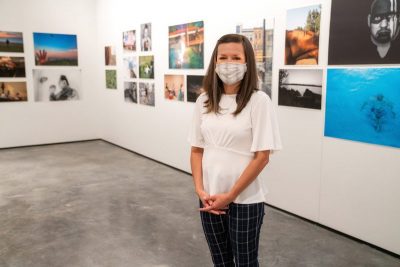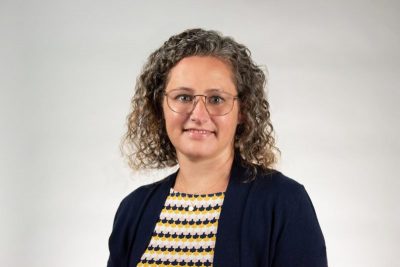The College of Visual and Performing Arts has established a new department of creative arts therapy and M.S. in art therapy program. This degree, and future programs, will be strengthened by collaborations between Syracuse University veterans’ resources, VPA, the Falk College, and the School of Education’s clinical mental health counseling program.
Imagine you are walking through the woods and come upon a wide, deep chasm. Your imaginary self has powers of any nature, so now picture yourself crossing the chasm by whatever means you’d like. If you were to put pen to paper and draw this scene, you’d have the basic building blocks for a conversation in art therapy, says Emily Nolan, professor of practice in Syracuse University’s College of Visual and Performing Arts (VPA).

Nolan will design and teach courses in the college’s new master’s program in art therapy. “One of the therapeutic properties of art is that it allows for externalization—what one creates, and the experience one has of creating, can lend insight into other aspects of one’s life and outlook,” she explains. In this case, for example, the method one chooses to cross the chasm and details in the drawing provide a way to understand one’s approach to handling real-life challenges.
The master of science in art therapy is the inaugural degree offering in VPA’s recently established Department of Creative Arts Therapy , which will welcome its first cohort to the hybrid, low-residency program in Fall 2021. “The department exemplifies the University’s commitment to interdisciplinary collaboration and innovation,” says Professor Jennifer DeLucia, who spearheaded the department’s development and now serves as chair.
DeLucia worked with faculty and administrators from across the University to lay the framework for programs and curricula rooted in existing University strengths. “Syracuse is a great place for creative arts therapy,” she says. “Not only will our programs draw on the wealth of expertise and breadth of knowledge within the other VPA departments; Falk College’s marriage and family therapy, human development and family science, and social work programs; and the School of Education’s clinical mental health counseling program, but we are also distinguished by our unique connection with the University’s veteran resources.”
Partnering with Veteran Services
Because of Syracuse University’s tremendous investment in supporting veterans and active duty personnel—both among students and in the wider community—the institution is uniquely positioned to advance therapeutic practice in military-connected populations, says DeLucia. DeLucia, who is also research associate for the University’s Institute for Veteran and Military Families (IVMF), has investigated the disconnect between many veterans’ military experiences and the stereotypes and assumptions they navigate when transitioning back to civilian life. This disjunction can lead to veterans feeling misunderstood and isolated—sentiments that are often exacerbated by social pressure to adapt to and accommodate civilian norms.
Art therapy has proven to be effective in helping veterans seeking opportunities for personal growth, as well as in addressing depression and other mental health concerns, and also in changing those conventional perceptions that can make reintegration into society very challenging, DeLucia says. The collaboration between the University’s creative arts therapy department and IVMF presents opportunities to meet the needs of this underserved population.
Art therapy can be applied in communal contexts as well as in individual and clinical counseling. The creative arts therapy department manages a gallery for community engagement around topics related to veterans and the military experience. This new campus asset is located in the National Veterans Resource Center . “Our work in the gallery evolves from the understanding that art can bridge divides, facilitate conversations and increase empathy,” says DeLucia, who serves as curator. “Our intention is to engage our community in transformative and therapeutic art experiences.”
Heating with Art

This semester, Nolan and DeLucia are teaching an elective course called Art for Healing, which offers graduate and undergraduate students the opportunity to explore how creating art can contribute to individual and communal health. Making art and discussing that art in a safe environment has many inherently therapeutic properties, Nolan explains. “The physicality of the process allows us to access different parts of our brains and potentially experience play or a meditative concentration,” she says. “Art also provides a lens focusing on our behaviors and personal symbology, and can foster understanding across diverse perspectives.” For this reason, therapeutic art practices can bring value to a range of other professions.
The master’s program is designed to give students a deep dive into both the theories and the practice of art therapy. “To learn to do this work, you have to meaningfully engage in it,” says DeLucia. The program will be limited to a small cohort so students can develop a supportive community in which to work through the material and build the emotional literacy essential to practice in this field. Both Nolan and DeLucia emphasize the value of learning from professors who are also active practitioners. “When we weave in our practice-based experience, students have a chance to grapple with issues at the forefront of the field,” says DeLucia.
The Department of Creative Arts Therapy will allow practitioners and researchers to address some of those issues, Nolan says. The department is part of the University’s virtual and immersive interactions research cluster, which brings together faculty in communications, computer science, information technology, human behavior and art therapy to focus on innovation in virtual and extended reality. The art therapy program will contribute to the cluster through scholarship and research in related areas of practice, including technology-assisted therapies and pedagogical methods that support the training of future educators and clinicians to employ technology-assisted practices.
“Having creative arts therapy graduate programs at a tier one research institution elevates the field to where it needs to be nationally and internationally,” says Nolan. “The support for research and the innovations possible through collaboration, not only within the University but with institutions and organizations around the world, will allow us to make a real difference.”
